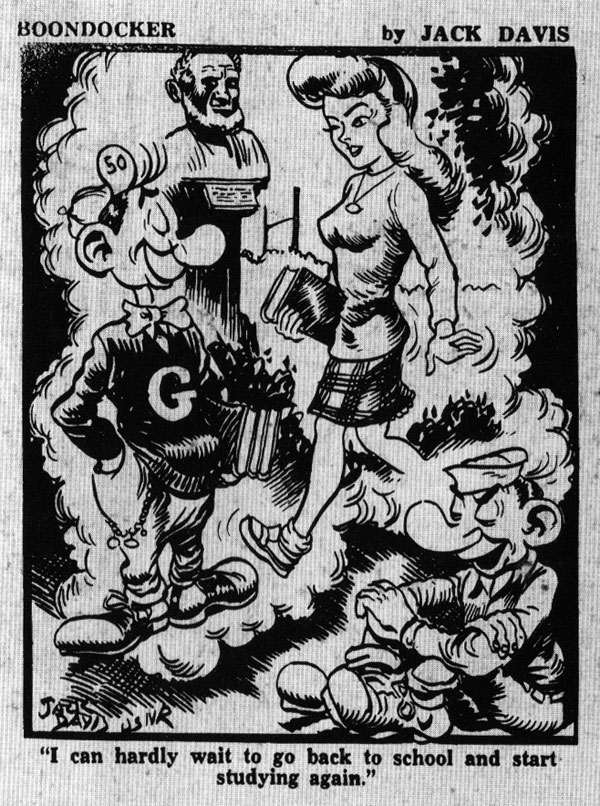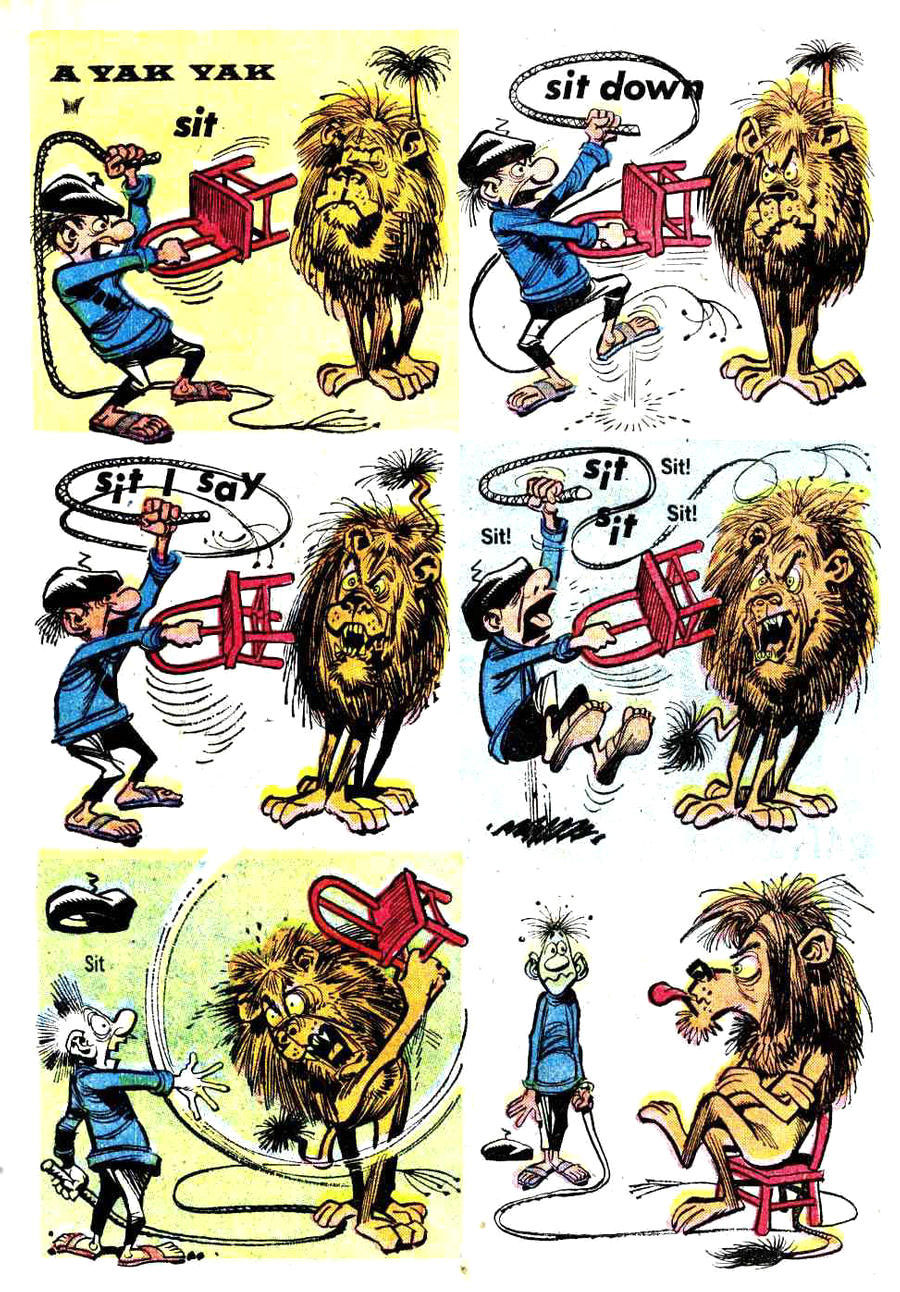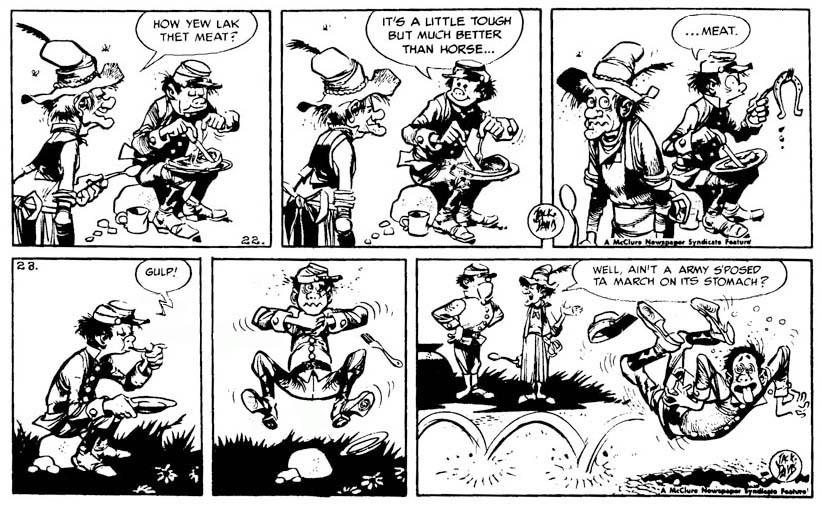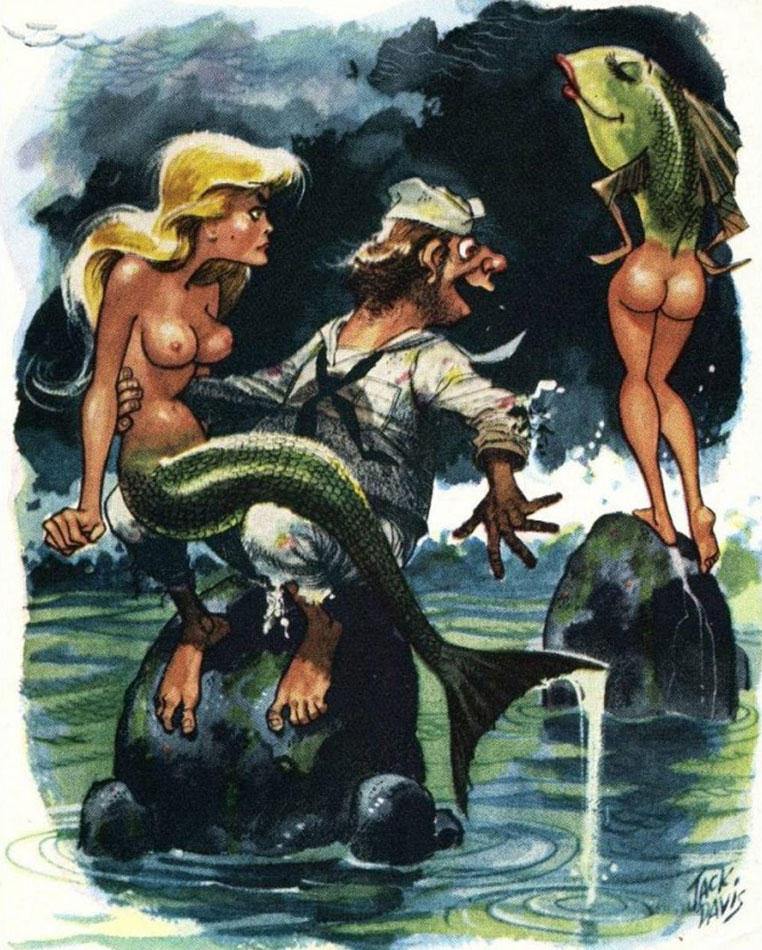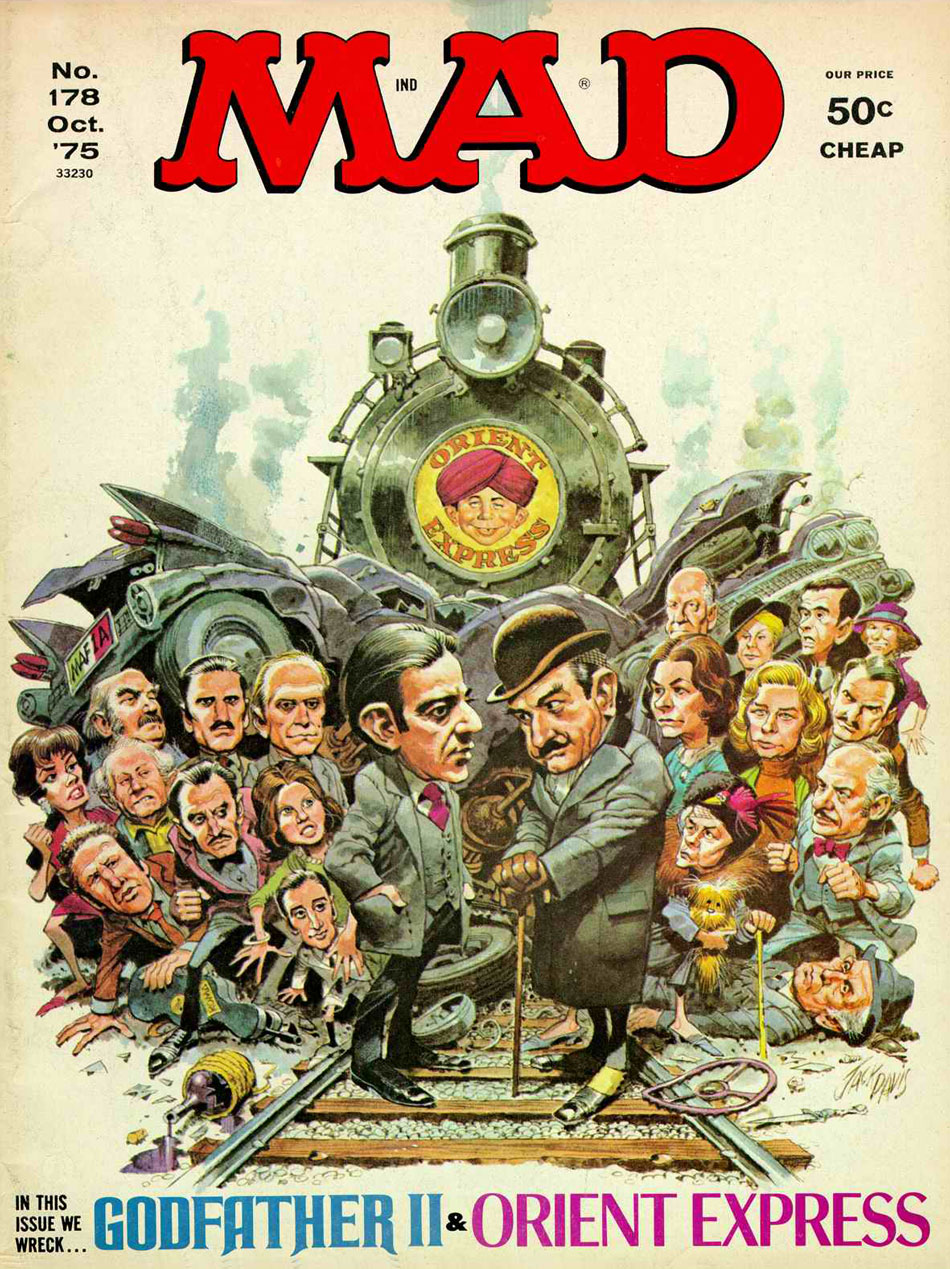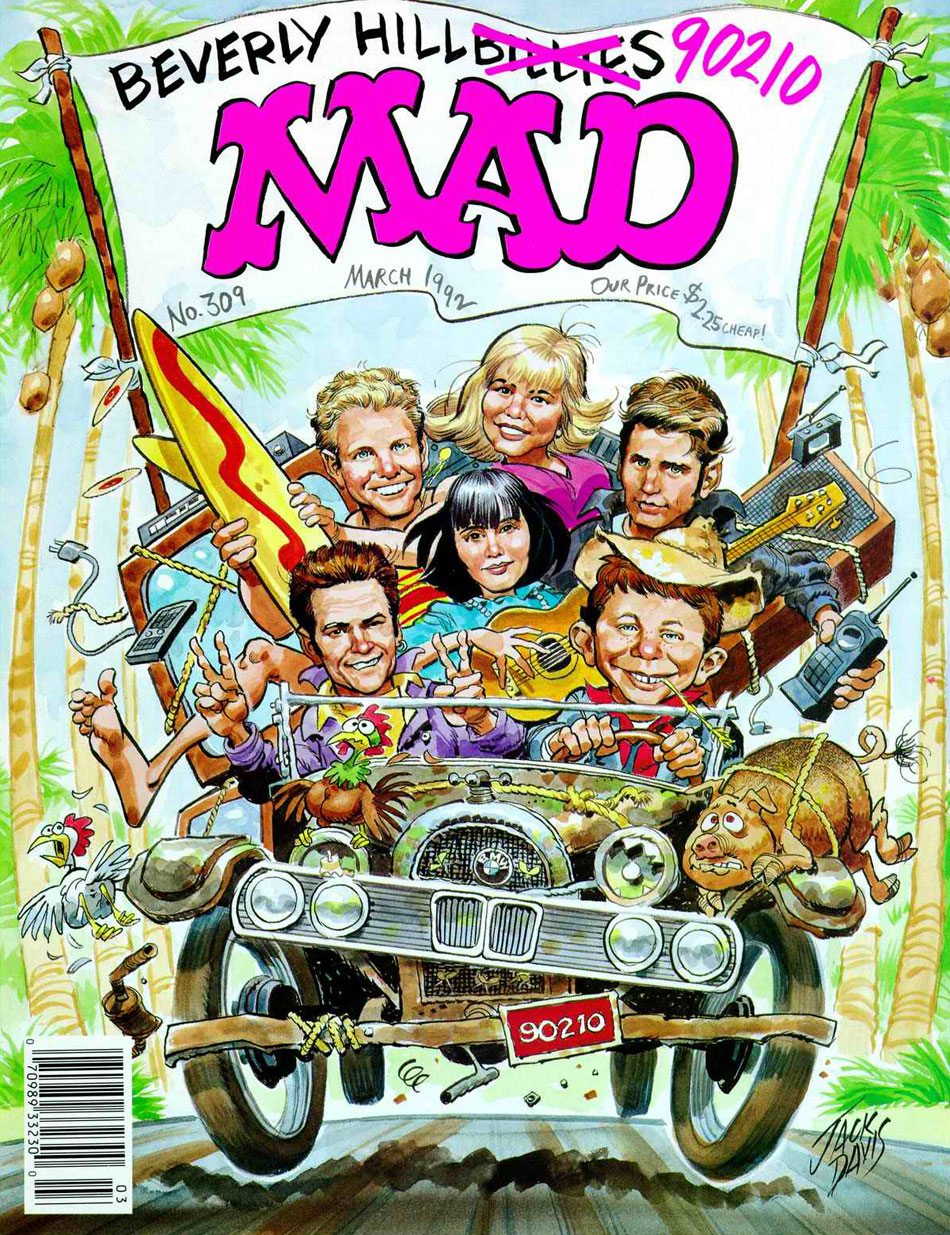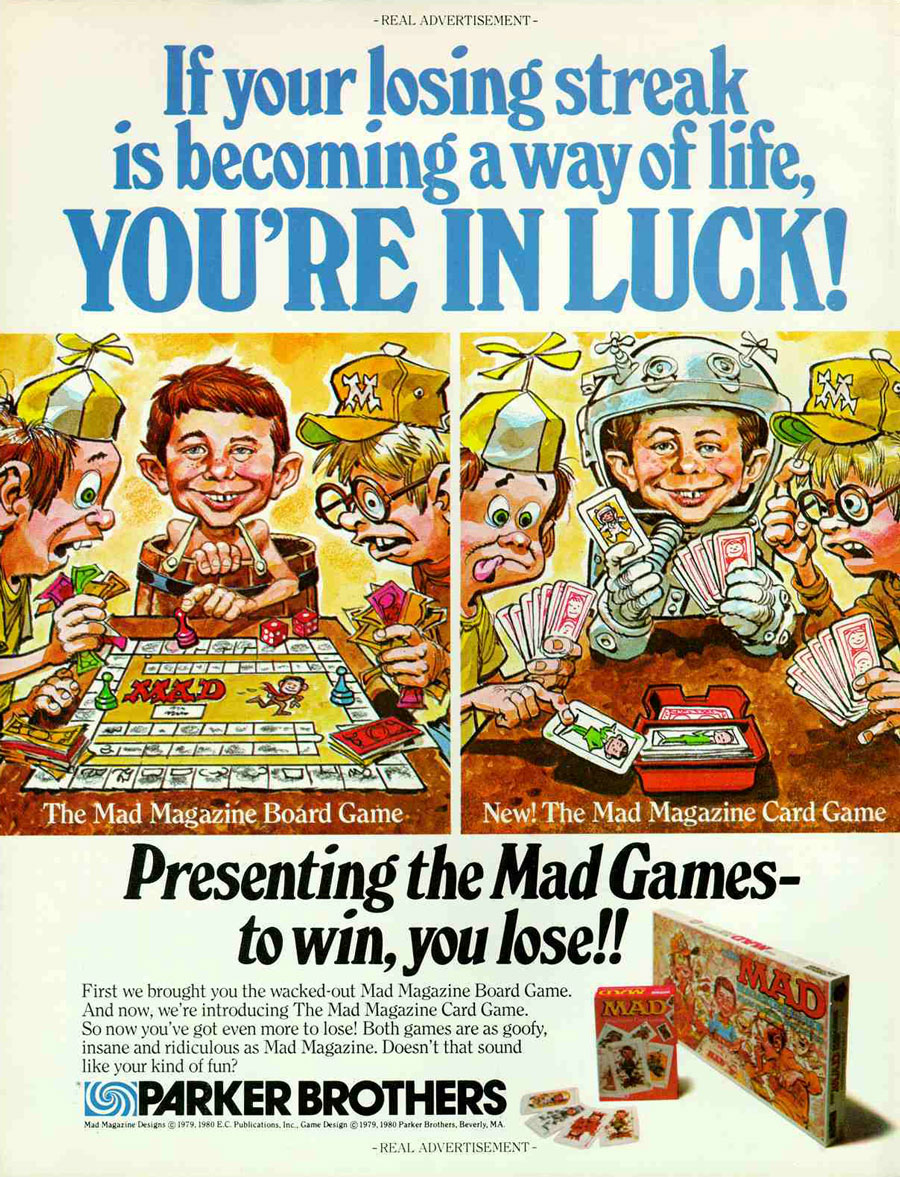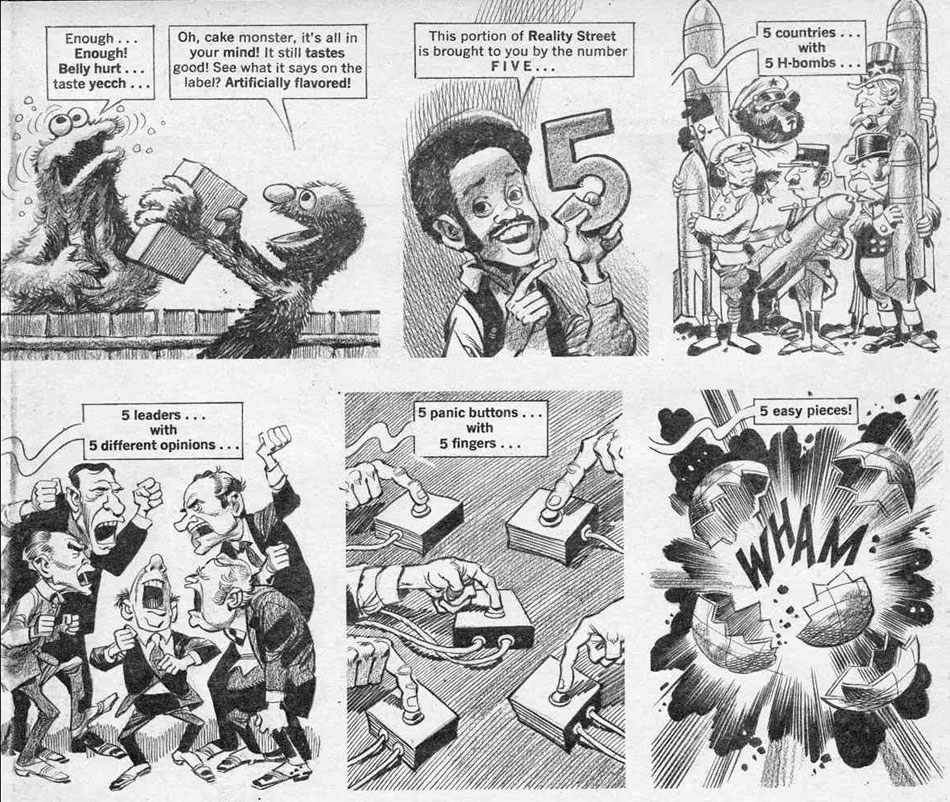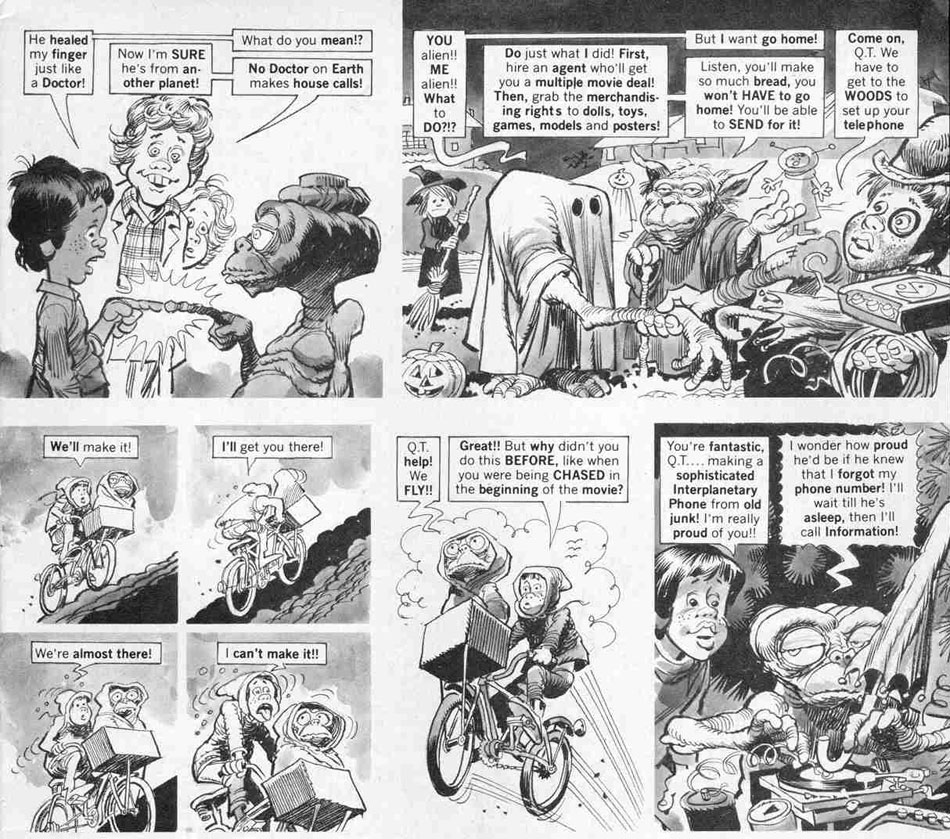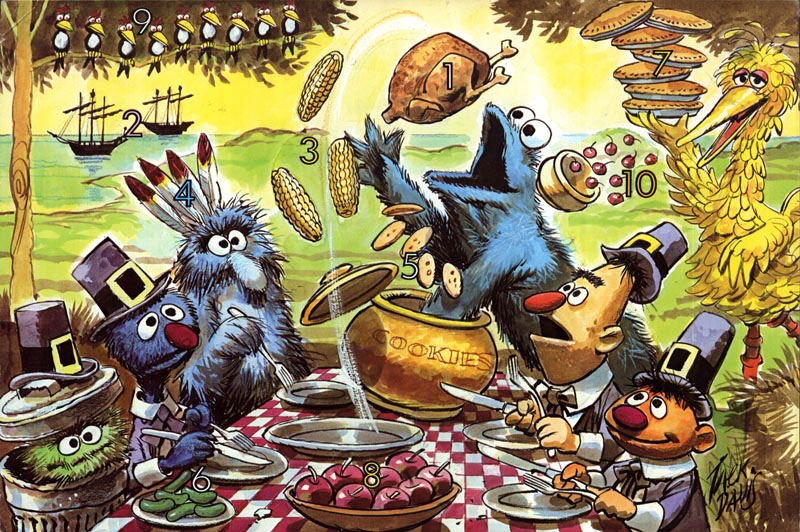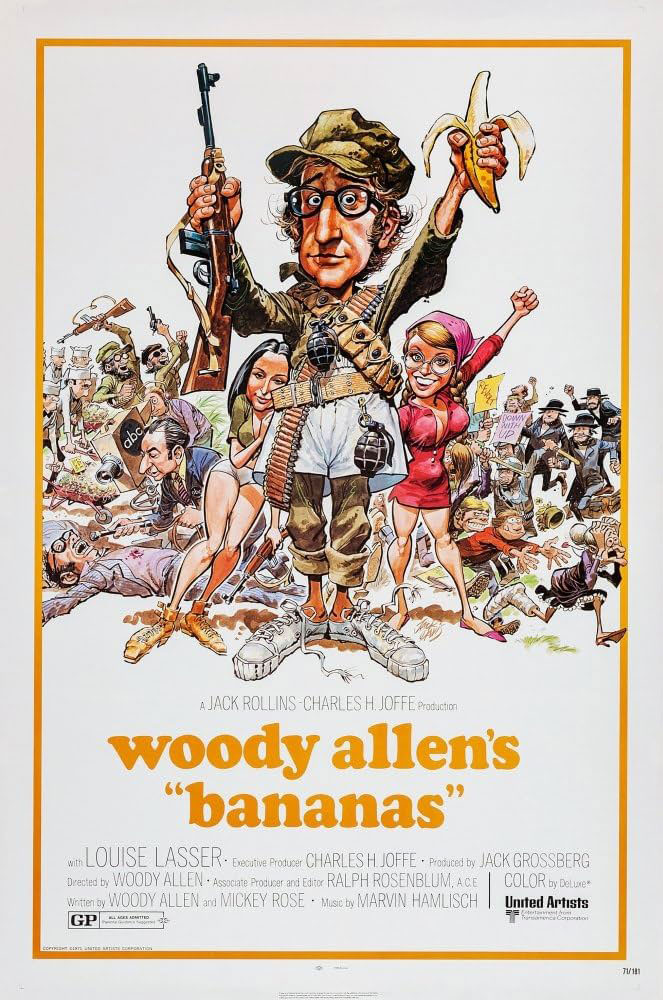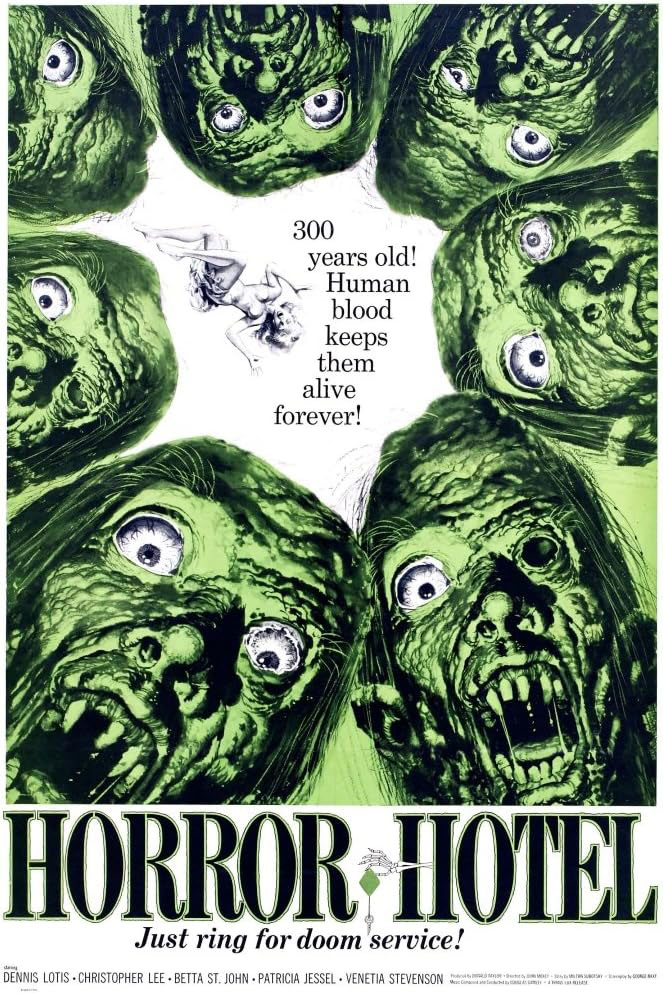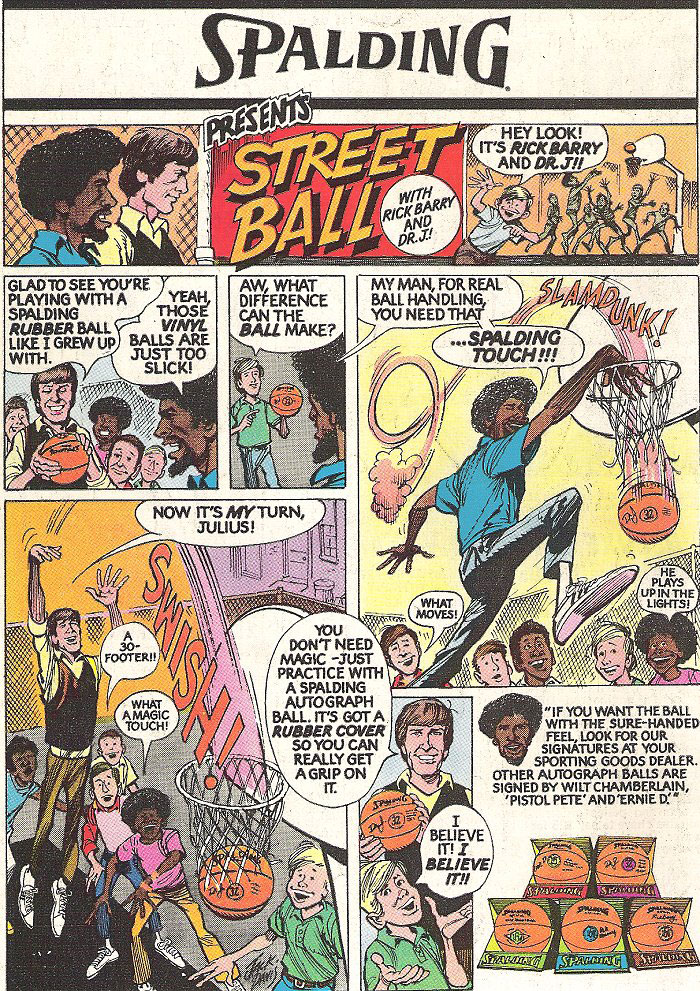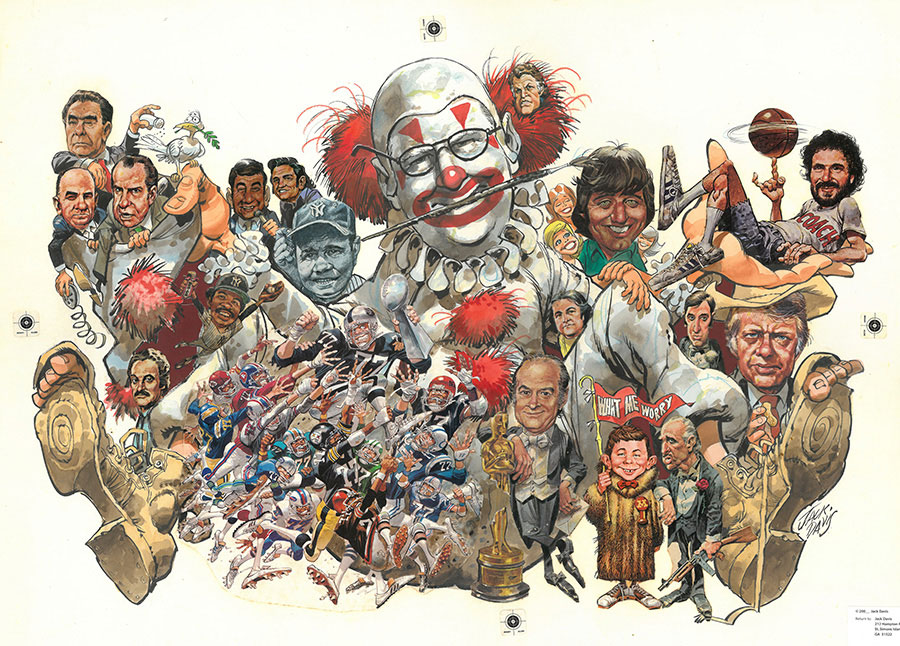'Hah! Noon!' (From Mad #9, February-March 1954), a parody of the movie 'High Noon'.
Jack Davis was an American comic artist, best-known as a long-running contributor to Mad Magazine. He was one of the pioneers during its first four years (1952-1956), when Mad was still a comic book under the editorship of Harvey Kurtzman. Davis drew various parody comics, articles and was the first artist to illustrate the long-running feature 'Scenes We'd Like To See' (1955). The tireless artist also designed several of Mad's fake advertisements, as well as real-life ads to promote subscriptions. Although Davis left Mad in 1956, he returned in 1965. Under new editorship of Al Feldstein and William M. Gaines, he kept contributing comics and other artwork for Mad until 1997. Davis also contributed to E.C. Comics' groundbreaking "New Trend" line of horror, war and suspense comic books. Together with Mad writer Nick Meglin, he created the sports gag comic 'Super Fan' (1970-1974) in the monthly American football magazine Pro Quarterback. Davis is renowned for his wild, energetic and chaotic style, which influenced numerous creators of humor comics. His drawings explode with movement. He excelled in amusing depictions of sports games, cowboys, grotesque people and monsters. His instantly recognizable art still adorned many advertisements, film posters, trading cards, board games, album and magazine covers. When he passed away, he was the last surviving pioneer artist of both E.C. and Mad's early years.
Early life
John Burton Davis, Jr. was born in 1924 in Atlanta, Georgia, as the only child of Jack Davis, Sr. and Callie Davis. By the time he was in grammar school, he was already copying his favorite comic strips, including E.C. Segars 'Popeye', Walt Disney's 'Mickey Mouse' and Carl Anderson's 'Henry'. He later drew for his school newspaper and yearbook. At age twelve, he won the first prize in "Buffalo Bob's Cartoon Contest", and took great pride in the prize money of one dollar, as it was his first printed work. Two years later, he sent in self-drawn comics to the United Feature comic book Tip Top Comics, with two of them appearing in the readers' sections of issues #9 (December 1936) and #32 (December 1938). Davis ranked Honoré Daumier, Heinrich Kley, Walt Disney, E.C. Segar, Milton Caniff, Alex Raymond, Harold Foster, Iggy Frost, George Baker, Bill Mauldin and Hank Ketcham among his main graphic influences. Later in life, he also expressed admiration for Gary Larson, Bill Watterson, Dik Browne, Jeff MacNelly and Pat Oliphant. When Hal Foster published his first Sunday page of 'Prince Valiant', Davis sent him a letter and received the original artwork in return.
'Boondocker' cartoon for the Navy News of 21 December 1945.
Seaman Swabby/Boondocker/Georgiae
In 1941, the United States entered World War II and, two years later, Davis was drafted into the U.S. Navy right after leaving high school. During his military training in Pensacola, Florida, he drew the one-panel gag cartoon 'Seaman Swabby' for his base newspaper, Gosport Weekly. The title hero was a bumbling, big-nosed sailor inspired by George Baker's similar military comic strip 'Sad Sack'. Davis spent his military service in Guam, Micronesia, fighting the Japanese army. He still found time to draw his 'Seaman Swabby' cartoon, but now under a different title, 'Boondocker' (1945-1946). The first entry was published in the Navy News on 2 December 1945. During the entire nine months he was stationed there, Davis drew a new panel every week.
Back in civilian life, Davis returned to Atlanta, where he studied art under Lamar Dodd at the University of Georgia. He published in the school paper The Red and Black, where he once again rebooted and retitled 'Boondocker'. This time the character became a student called 'Georgiae', who had just left the army. Together with some fellow students, Davis founded a humor magazine called Bullsheet. Since Bullsheet wasn't sold on campus, it allowed for more risqué comedy. Davis made some cartoony depictions of bulldogs around this time, which were adapted as mascots for the American football team, associated with the University of Georgia. Nevertheless, Davis never graduated.
'Two-Fisted Tales' #25 (January-February 1952).
Early comics career
In 1947, Davis found a summer job as assistant to Ed Dodd on his newspaper comic 'Mark Trail' in The New York Post. Dodd encouraged him to take some additional drawing lessons at the Art Students League in New York City, but Davis didn't have the finances to move there. Two years later, a well-paid assignment by the Coca Cola Company for illustrating an in-house instructional booklet earned him enough money to eventually head for New York. There, he attended the Art Students League in the evenings, while during daytime trying to get his work picked up by syndicates and comic book publishers. Eventually, he was hired by The New York Herald Tribune to ink Mike Roy's spy series 'The Saint', which he did for about a year. After that, he drew some comics for the western comic book Lucky Star (1950-1951) by Nation-Wide Publishing, but otherwise he had little success finding work
EC Comics
In 1951, down on his luck, Davis walked into a newspaper stand and noticed one of the comic books of EC Comics. As he picked up the issue, he noticed their company address inside. Rather than read or buy the issue, he quickly scribbled down the address on a piece of paper, while the store owner wasn't looking. Despite not knowing what kind of comics EC produced., Davis applied for a job and was interviewed by editor Al Feldstein, who instantly hired him, At the time, the company built up a reputation for thrilling, controversial suspense, horror and war comics, published in their "New Trend" line of comic books. Davis' first commission was illustrating one of Feldstein's stories, 'The Living Mummy', for 'The Haunt of Fear' issue #4. Much to the editor's surprise, the young recruit completed the full story in one night and turned it in the next day. From that moment on, Jack Davis became EC's most reliable and efficient artist.
'Who Doughnut?', from The Vault of Horror #30 (April-May 1953).
Between 1950 and 1955, Davis published in all of EC's horror, mystery and suspense titles, including 'The Vault of Horror', 'Tales From The Crypt', 'The Haunt Of Fear', 'Crime SuspenStories', 'Shock SuspenStories' and 'Incredible Science Fiction'. Davis additionally drew stories for EC's war title 'Two-Fisted Tales', edited by Harvey Kurtzman. As a lifelong fan of B-horror movies, he loved drawing monsters and witches. His scratchy cartoony style proved a perfect match with the story's gruesome subject matter and ironic twists. Heads and limbs were often out of proportion, while the faces looked grotesque. Davis also redesigned one of EC's horror mascots, the Cryptkeeper, who was originally created by Al Feldstein.
'Foul Play!', one of the all-time classic EC horror stories (The Haunt of Fear #19, May/June 1953).
Davis' story 'Foul Play' (The Haunt of Fear issue #19, May/June 1953), about a baseball player who ends up being dismembered on the field, gained notoriety when Dr. Fredric Wertham mentioned it in his book 'Seduction of the Innocent' (1954) and reprinted imagery, using it as a prime example of the "dangers" of comics in "depraving the youth." Wertham's book fueled a media scare, where moral guardians wanted a ban on comics like these. By 1956, the witch hunts against "dangerous comics" effectively forced EC to discontinue all of their "violent" comic titles, under pressure of the industry-established Comics Code. In later interviews, Davis dismissed 'Foul Play' as a story "I wished I never made", with Gaines and Feldstein also referring to it as respectively "a stupid story (...) in bad taste" and "an atrocity". Davis even went so far as to distance himself from all the horror stories he had ever drawn for EC Comics, claiming he was young and had a family to feed.
'Kane Keen! - Private Eye!' (Mad Magazine, issue #5, June 1953).
Mad: first era (1952-1957)
While he was a prominent artist in EC's horror titles, Davis found a more suitable spot in one of the publisher's other publications. In October 1952, EC Comics brought out the first issue of Mad Magazine, with Harvey Kurtzman as chief editor and main scriptwriter. Mad specialized in zany humor comics, mostly delving into satire and parody. Davis was present from the first issue on, parodying the kind of horror comics EC was notorious for ('Hoohah'). He showed a gift for self-mockery when his previous story, 'Murder the Husband!' (Crime SuspenStories, issue #12, August-September 1952) was reprinted in Mad issue #11 (May 1954) and then deconstructed by Kurtzman by having inappropriate text added in the speech balloons. In the same issue, Kurtzman and Davis also spoofed Ed Dodd's 'Mark Trail' (issue #12, June 1954), the newspaper strip Davis once worked on as an assistant. Contrary to some of his colleagues, Davis didn't spoof any other famous comic series in Mad. The one exception, 'Flob Was A Slob!' (issue #4, April 1953), was more a spoof of romantic comics in general than a specific title.
In Mad issue #2 (December 1952), Davis designed his first cover. Like all artists during Mad's pioneer years, he illustrated stories from a script by Harvey Kurtzman. Among them were parodies of 'The Lone Ranger' (issue #3, January 1953 and issue #8, December 1953), 'Casey at the Bat' (issue #6, August 1953), 'High Noon' (issue #9, 1954), 'The Barefoot Contessa' (issue #23, May 1955), 'Vera Cruz' (issue #24, July 1955) and the TV shows 'The Dave Garroway Show' (issue #26, November 1955) and 'Gunsmoke' (issue #30, December 1956).
A classic spoof by Kurtzman and Davis is 'Kane Keen! - Private Eye' (issue #5, June 1953), which ridicules two radio detective series at the same time, namely 'Mr. Keen, Tracer of Lost Persons' and 'Martin Kane, Private Eye'. Equally notable is their take on Lewis Carroll's 'Alice in Wonderland' (issue #18, December 1954), in which Davis imitated John Tenniel's classic illustrations. Their most audacious parody attacked the quiz show 'What's My Line?' (issue #17, November 1954), with a daring satire of Joseph McCarthy's anti-communist witch hunts. McCarthy is present as a panel member on the show, accusing the mystery guest of being "a redskin" (in this context not a Communist but a Native American) and produces a photo, which later turns out be forged. When McCarthy is confronted with his scam, a huge fight breaks out, thus ending "the friendly guiz game for the whole friendly family."
Davis was the first artist to illustrate one of Mad's longest-running features, namely 'Scenes We'd Like To See'. The first episode, written by Kurtzman, appeared in issue #23 (May 1955). Each gag shows a typical situation from a famous fairy tale, comic strip, film, novel or TV show, but with a funny twist. Apart from comics, Davis was frequently commissioned to parody real-life advertisements. He was also the first Mad artist to draw ads which promoted subscriptions to Mad Magazine.
Style
Jack Davis was at his best when depicting scenes of chaos and mayhem. His drawings are praised for their ability to express tremendous energy. His characters often rush around, barely able to stay inside their panels. He drew them with long, sloppy, clown-like feet, which give their movements a comical look. Davis could accelerate the madness by drawing large, swarming crowds, tumbling and falling over each other. Even when they stand still, his characters are rarely at ease. Many are nervous, panicking or simply in a hurry. This style may have been an expression of Davis' personal battles against deadlines. He was nevertheless known as an exceptionally quick and efficient artist. According to his colleagues, he could whip out excellent and complicated drawings while simply killing time in waiting rooms. Davis was equally swift in drawing trashy environments.
One of Davis' other graphic trademarks was his use of grey paint for black-and-white drawings, while his color work was done in watercolors. According to legend, he relied on ordinary water paint sets for children. Interviewed by Jim Woodring for The Comics Journal in 2000, Davis confirmed he once used lake water to make a watercolor painting during a camp trip. His only complaint was that it had mud in it. He also told Woodring that he once used a few sips of bourbon as water paint. Davis' typical grimy, disheveled graphic style was the result of his habit to cross-hatch his drawings.
Leaving Mad (1957-1965)
In 1956, Harvey Kurtzman left Mad Magazine out of creative differences with publisher Bill Gaines. Davis followed his example, although some of his material still appeared in its pages in 1958. Also present in Kurtzman's new satirical magazine Trump, Davis provided various humor comics, satirical ads and drew two film spoofs, one lampooning 'Rin-Tin-Tin' (issue #1) and the other the James Dean movie 'Giant' (issue #2). In Kurtzman's next, equally short-lived magazine Humbug, Davis drew a satire of the films 'Baby Doll' (issue #1, August 1957), 'Man of A Thousand Faces' (issue #6, January 1958), the play 'My Fair Lady' (issue #2, September 1957) and a mock-Russian version of 'Flash Gordon' ('Flyashi Gordonovich' in issue #10, June 1958). One of the most often reprinted articles in Humbug was 'Fun with Hamlet & His Friends' from issue #7 (February 1958), drawn by Jack Davis and scripted by Larry Siegel. It reinterpreted Shakespeare's classic play as an episode of the children's novel series 'Fun with Dick and Jane'. Some time later, the National Observer reprinted the article without crediting Siegel or Davis. Siegel wrote them a sarcastic letter of complaint, only slightly joking: "If I don't receive credit, I will sue, sue, sue you. What fun it will be to sue you!"
Jack Davis was also present in Kurtzman's magazine, Help! (1960-1965), where one of his notable series was 'Beauregard!' (1961), a gag comic set during the U.S. Civil War. 'Beauregard' was actually a rejected newspaper comic, once considered for publication by the McClure Syndicate, which eventually decided not to run it, as the U.S. Civil War was still a touchy subject, especially when treated humorously.
Between 1958 and 1963, Davis worked for Atlas Comics, returning to mystery and suspense stories for anthology titles like 'Journey into Mystery', 'Journey into Unknown Worlds', 'Strange Tales', 'Tales of Suspense' and 'World of Mystery'. He also drew western stories for 'Frontier Western', 'Gunsmoke Western', 'Rawhide Kid', 'Two-Gun Kid' and 'Kid Colt Outlaw'. Between 1964 and 1970, Davis made some cover and interior illustrations for Creepy and Eerie by Warren Publishing, two magazines that tried to revive EC's golden days of horror comics.
Playboy cartoon by Jack Davis.
In Hugh Hefner's Playboy magazine, he drew erotic cartoons and ghosted a few episodes of Kurtzman and Will Elder's erotic feature 'Little Annie Fanny'. His drawings were found in several other humor magazines that imitated Mad, such as Cracked, Slick, Loco and Crazy. Sick also featured reprints of 'Beauregard!'. Davis even tried to launch his own version of Mad, called Yak Yak (Dell Comics, 1961). Contrary to other Mad rip-offs, Davis did all the writing and artwork in Yak Yak himself. This eventually proved to be too exhausting, and Yak Yak only lasted two issues. The best thing about the experience was that Davis realized that if he was going to make a Mad-style magazine anyway, he might as well just make a comeback in Mad itself.
Jack Davis cover drawings for Mad issues #178 (October 1975), bringing the cast of 'The Godfather II' and 'Murder on the Orient Express' together, and #309 (March 1992), portraying the soap opera characters of 'Beverly Hills 90210' as 'The Beverly Hillbillies'.
Mad: second era (1965-1997)
In 1965, Davis returned to Mad, which had by now switched from comic book to magazine. He stayed with the title for the majority of his remaining career. This made him a rare example of a pioneer from Mad's first four years (1952-1956) to return as a long-running contributor afterwards. Most of his colleagues from the early years left after chief editor Harvey Kurtzman resigned, and never or only occasionally worked for Mad again. Part of the "usual gang of idiots" for decades, Davis was usually commissioned whenever the writers needed illustrated covers, articles or comics involving cowboys, monsters, sport scenes or huge, swarming crowds. Among his best-remembered covers are those of issue #139 (December 1970), depicting Mad mascot Alfred E. Neuman among a group of angry hippie protesters, and issue #309 (March 1992), depicting the cast of the soap opera 'Beverly Hills 902010' driving the same overcrowded car as the cast from the sitcom 'The Beverly Hillbillies' in their opening credits.
Advertising for the Mad Games, printed in Mad #219 (December 1980).
Davis also illustrated advertisements for Mad, particularly to motivate readers to get a subscription. He livened up the covers of various Mad paperbacks, such as 'It's A World, World, World, World Mad' (1965), 'A Mad Look At Old Movies' (1966), 'The Return Of A Mad Look At Old Movies' (1970), 'The Mad Jock Book' (1983) and 'A Mad Guide To Parents, Teachers and Other Enemies' (1985). In 1979, he provided artwork to the Mad Magazine Board Game and Card Game. In true Mad fashion, the winner of these two games is actually the loser (and vice versa).
Davis only left the magazine in 1997. According to reports, he didn't like the more "vulgar" direction Mad took in the 1990s, when more blatant references to sex and drugs were made in new issues.
'Crapper John M.D.' (Mad #221, March 1981)
Mad: TV parodies
Between 1965 and 1997, Davis illustrated several TV parodies in Mad, such as 'Hogan's Heroes' (scripted by Larry Siegel, issue #108, January 1967), 'Daktari' (scripted by Dick DeBartolo, issue #109, March 1967), 'Sesame Street' (also written by Dick DeBartolo, issue #146, October 1971), 'Cannon' (with Dick DeBartolo, issue #160, July 1973), 'Trapper John M.D.' (scripted by Stan Hart, issue #221, March 1981), 'M.A.S.H.' (written by Arnie Kogen, issue #234, October 1982) and 'Rescue 911' (with Dick DeBartolo, issue #326, March/April 1994).
The most controversial of these TV satires was 'Hogan's Heroes'. Writer Larry Siegel was a World War II veteran and felt a TV sitcom set in a Nazi POW camp was in particularly poor taste. So much that he ended his spoof with a very controversial splash panel called 'Hochman's Heroes', about a supposed "spin-off" of 'Hogan's Heroes' set in Nazi concentration camp Buchenwald, where all the inmates "have so much fun in this fantastic place", which they call "American Television Humor at its best."
'Sesame Street' parody in Mad #146 (October 1971).
Mad: film parodies
As could be expected, Davis also drew film parodies for Mad, among them: 'Dr. Zhivago' (written by Dick DeBartolo, issue #113, September 1967), 'A Fistful of Dollars' (with Lou Silverstone, Mad Special #4, Fall 1971), 'The Bad News Bears' (scripted by Stan Hart, issue #188, January 1977), 'Raiders of the Lost Ark' (written by Dick Debartolo and Frank Jacobs, issue #228, January 1982), 'E.T.' (scripted by Stan Hart, issue #236, January 1983), 'Scarface' (with Larry Siegel, issue #248, July 1984), 'The Goonies' (script by Stan Hart, issue #258, October 1985), 'Aliens' (script by Dick DeBartolo, issue #268, January 1987), 'Predator' (issue #276, January 1988) and - for its 300th issue in January 1991 - 'Gone With The Wind' (with Stan Hart). His spoof of 'The Bad News Bears' again proved that he wasn't afraid to poke fun at himself. Earlier, Davis had designed the poster for that film.
'E.T.' parody for Mad #236 (January 1983).
Super Fan
For the monthly American football magazine Pro Quarterback, Davis drew a sports comic named 'Super Fan' (1970-1974), scripted by Nick Meglin. It told the story of Y.A. Schmickle, a geeky boy who becomes a champion thanks to a magic spell. The comic satirized much of early 1970s culture and society, while many well-known American football players of the day had cameo appearances. In 1972, a paperback compilation was published by Signet, with the legendary sports journalist Howard Cosell writing the foreword.
Commercial illustrator (1960s-1990s)
Between 1968 and 1981, Davis designed 23 covers for TV Guide magazine, caricaturing television celebrities. For the 'Raid' insecticide product, he designed the bug who appeared in their TV commercials, as well as creating the mascot for the College of Coastal Georgia and drew illustrations for the local university. His art also livened up pages in magazines like Time and Esquire.
During the 1970s, Davis was a notable illustrator for products related to Jim Henson's 'Sesame Street' puppet TV show. His drawings, all carrying his own distinctive style, appeared in Sesame Street Magazine, puzzles and on the Sesame Street Calendar 1972. His association with 'Sesame Street' was particularly notable, since in 1971 he also spoofed the TV show in Mad Magazine.
Davis also provided character designs for the animation company Rankin-Bass, particularly for the cult film 'Mad Monster Party' (1967) - scripted by Harvey Kurtzman - as well as the TV cartoon series 'The King Kong Show' (1966-1969), 'The Jackson Five' (1970-1971) and 'Coneheads' (1981). In the mid-1970s, he drew an advertising comic for 'Spalding' basketballs. In 1989, Davis was commissioned with designing an official stamp for the U.S. Postal Service, paying homage to its letter carriers.
'Sesame Street' illustration by Jack Davis.
Graphic contributions
Jack Davis designed posters for comedy films like 'It's a Mad, Mad, Mad, Mad World' (1963), 'The Party' (1968), Woody Allen's 'Bananas' (1971), and 'The Bad News Bears' (1976), but also for serious pictures such as 'Kelly's Heroes' (1970), 'The Long Goodbye' (1973) and 'American Graffiti' (1973). He livened up the album covers for comedy records by Spike Jones, Bob & Ray, Gene Moss, Homer & Jethro, Jonathan Winters, John Zacherle and Weird "Al" Yankovic, as well as record sleeves of other artists, such as Harry Arnold & His Orchestra's 'The Jazztone Mystery Band' (1957), Tito Puente's 'Cha Cha with Tito Puente at Grossinger's' (1960), Johnny Cash's 'Everybody Loves A Nut' (1966) and White Trash's 'White Trash' (1991). Davis also illustrated the cover of Frank Jacobs' book 'Mad Zaps the Human Race' (1984).
Movie posters by Jack Davis for Woody Allen's 'Bananas' (1971) and the horror film 'Horror Motel' (1960), A.K.A. 'The City of the Dead'.
Recognition
In 1985, Jack Davis received an Inkpot Award. The National Cartoonists' Society gave him both the Milton Caniff Lifetime Achievement Award (1996) and Reuben Award for "Best Cartoonist of the Year" (2000). In 2003, he was inducted in the Eisner Award Hall of Fame, followed a decade later by an induction into the Ghastly Award Hall of Fame (2014). During the 2019 Inkwell Awards, Davis was posthumously bestowed with the Stacey Aragon Special Recognition Award and a Harvey Kurtzman Hall of Fame Award.
Death
On 16 December 2014, at the age of 90, Jack Davis announced his retirement from drawing, because he "couldn't meet his own standards anymore". He died in 2016 in Athens, Georgia, from complications of a stroke. He was 91 years old. At the time of his death, he was the oldest surviving Mad contributor from the pioneer years under Harvey Kurtzman's editorial command (1952-1956). His passing was commemorated on Twitter by Peter Lord (Aardman Animation) and Joe Dante (director of 'Gremlins').
Advertising strip for Spalding basketballs (mid-1970s), depicting basketball champions Rick Barry, Jr., and Dr. J., A.K.A. Julius Erving. In the final panel, Wilt Chamberlain, 'Pistol Pete' (Pete Maravich) and 'Ernie D.' (Ernie DiGregorio) are mentioned. Reprints later replaced the second two names with new players: Larry Bird and "Magic" Johnson. This well-known ad was also spoofed by an uncredited artist in Matt Groening's 'The Simpsons Comics', #17 (February 1996), as 'Dartin' Around', starring Krusty the Clown and Sideshow Mel.
Legacy and influence
Jack Davis' zany and nervous drawing style has influenced many artists. In the United States, he has been an inspiration to Peter Bagge, Joel Beck, Mike Diana, Drew Friedman, Guy Gilchrist, Terry Gilliam, Phil Hester, Charles King, Rick Meyerowitz (whose poster for the 1978 film 'Animal House' is often mistaken for Jack Davis' art), Howard Nostrand, Rick Parker, Everett Peck, Rich Powell, Tom Richmond, Jim Scancarelli, Art Spiegelman, Jim Woodring (who claimed that Davis' 1966 record cover for 'Dracula's Greatest Hits' by Gene Moss was an early inspiration), Bernie Wrightson and Adam Zyglis. Jack Davis also drew admiration from his colleague John Severin.
In Canada, Jack Davis was an influence on Darwyn Cooke. In Europe, he has followers in Belgium (Jean-Louis Lejeune, Ever Meulen, Morris, Stef Vanstiphout, François Walthéry), France (Gotlib, Nikita Mandryka, Jean-Claude Mézières, Jean-Claude Morchoisne, Wolinski) and the Netherlands (Theo van den Boogaard, Charles Guthrie, Jan van Haasteren, Eric Heuvel, Marnix Rueb and Mark Smeets).
In Mad issue #163 (December 1973), a letter by TV actor William Conrad was printed, regarding their spoof of 'Cannon' three issues earlier (written by Dick Debartolo and drawn by Jack Davis). Conrad wrote, accompanied by a photo of him reading Mad, that his son never understood his dad's successful TV career, but felt that he "really made it" once he was parodied in Mad. On the cover of Mad issue #339 (September 1995), Davis drew Mad's mascot Alfred E. Neuman plunging radio host Howard Stern out of a toilet. Stern was thrilled when he saw the cover and called it "my greatest career highlight". As he explained it: "I think he was one of the greatest artists ever. I worshipped the guy when I was a kid." Stern invited Mad editors Nick Meglin and John Ficarra over on his show to express his gratitude. Interviewed by Edwin Pouncey for Sounds Magazine (23 January 1983), rock musician Frank Zappa revealed that Jack Davis was one of the comic artists he liked. In an interview with CNN, conducted by Todd Leopold on 26 February 2009, Matt Groening said that both Jack Kirby and Jack Davis were heroes of his, whom he met personally: "They're definitely part of my pantheon of great artists." When Tom Richmond was commissioned by Quentin Tarantino to draw a Mad Magazine cover for his film 'Once Upon A Time in Hollywood' (2019), depicting Leonardo DiCaprio's character in that movie, he was asked to mimic Davis' graphic style.
Self-portrait. Among the people surrounding Davis are (from left to right) Russian head of state Leonid Brezhnev, U.S. president Richard Nixon, sports commentator Howard Cosell, country singer Johnny Cash, baseball champion Babe Ruth, comedian Bob Hope, U.S. politician Ted Kennedy (in his clown hair), Mad mascot Alfred E. Neuman, Marlon Brando (as Don Corleone in 'The Godfather'), Al Pacino and U.S. President Jimmy Carter.




